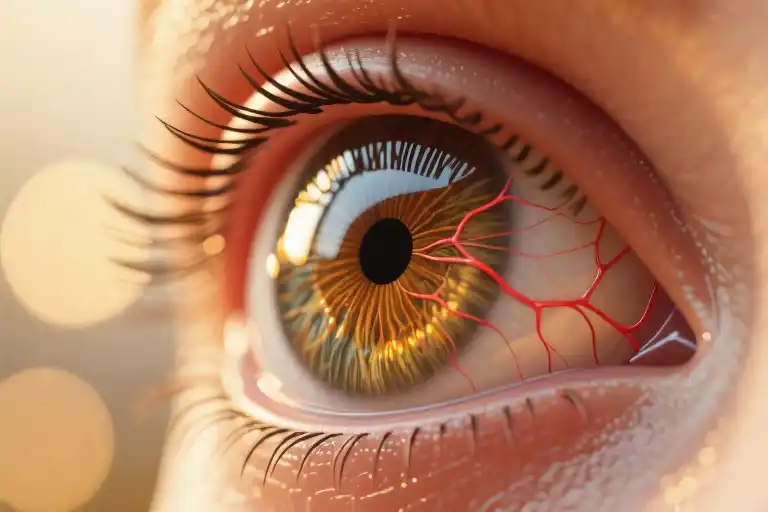The human eye isn’t just your window to the world—it’s a biological supercomputer that puts most tech gadgets to shame. While your office Wi-Fi struggles with Zoom calls, each of your eyes transmits data to the brain at a staggering 1 gigabit per second, faster than many wired internet connections. This intricate organ contains over two million specialized parts working in perfect harmony, capable of distinguishing between 10 million colors and adjusting focus quicker than the most advanced camera lens.
But here’s what tech still can’t replicate: your eyes silently document your overall health like a medical diary. Beyond processing visual information, they reveal subtle clues about conditions ranging from diabetes to—as groundbreaking 2024 research shows—even mental health patterns. Recent findings published in Nature Mental Health suggest that the thickness of your retina might hold secrets about neurological conditions we’re only beginning to understand.
Consider this: your pupils don’t just respond to light—they react to your thoughts and emotions. That momentary dilation when you see someone you love? That’s your autonomic nervous system in action. The delicate blood vessels in your retina provide the only non-invasive view of your circulatory system, allowing doctors to spot early signs of hypertension or cholesterol buildup. Now scientists are discovering that the same retinal tissue might offer insights into brain health through what researchers call the ‘eye-brain axis’.
The real marvel lies in how this biological wonder achieves such feats. Your retina—that paper-thin layer at the back of your eye—functions like nature’s ultra-HD sensor, containing specialized cells that convert light into neural signals with precision that still baffles engineers. Rod cells detect single photons in near darkness, while cone cells allow you to appreciate every hue in a sunset. This constant data stream flows through your optic nerve at speeds that would make fiber optics jealous, all while consuming less energy than a smartphone flashlight.
What makes these discoveries particularly compelling is their potential to transform healthcare. Unlike brain scans that require expensive machinery, retinal imaging offers a quick, painless window into neurological health. The same eye exam that checks your vision might someday provide early warnings for conditions we currently diagnose through lengthy behavioral assessments. As research continues to unravel the eye-health connection, one thing becomes clear: regular eye check-ups aren’t just about preserving vision—they’re about safeguarding your overall wellbeing.
The Biological Marvel of Your Eyes
Your eyes are engineering masterpieces that outperform the most advanced human-made technologies. With over two million intricately coordinated working parts in each eye, this biological wonder transmits visual data to your brain at staggering speeds – approximately 1 gigabit per second. To put this into perspective, your eyes process information faster than most office Ethernet connections can transfer data between computers.
Nature’s Ultra-High-Definition Camera
The human eye operates with precision that puts professional cameras to shame. While the latest DSLR might boast rapid autofocus capabilities, your pupils adjust to changing light conditions instantaneously – no mechanical parts required. This seamless adaptation happens continuously throughout your day, whether you’re stepping from bright sunlight into a dim room or focusing between near and distant objects.
What’s even more remarkable is your eyes’ ability to distinguish between 10 million subtle color variations. This chromatic sensitivity surpasses even high-end digital displays, which typically reproduce about 16.7 million colors through artificial means. Your natural vision accomplishes this feat through specialized photoreceptor cells called cones, which work in perfect harmony with your brain’s visual processing centers.
The Eye-Brain Superhighway
Consider the complex coordination required every time you glance at your morning coffee:
- Light enters through the cornea, which provides 65-75% of your eye’s focusing power
- The iris adjusts pupil size like a camera aperture within milliseconds
- The lens fine-tunes focus by changing shape (accommodation)
- Photoreceptor cells in the retina convert light into electrical signals
- Over 1 million nerve fibers in each optic nerve transmit this data at fiber-optic speeds
This entire process occurs faster than you can consciously perceive – a testament to evolution’s engineering prowess. Unlike computer networks that require physical cables, your eyes maintain this incredible bandwidth through biological neural pathways that have been refined over millions of years.
More Than Meets the Eye
While we often compare eyes to technological devices, this analogy barely scratches the surface of their true capabilities. Your visual system doesn’t just capture images – it actively interprets, predicts, and constructs your visual reality. The retina itself performs preliminary processing before signals even reach your brain, functioning more like an extension of your central nervous system than a simple optical sensor.
This biological complexity explains why eye health often reflects overall wellbeing. The same delicate tissues that enable your impressive visual capabilities can also reveal early signs of systemic conditions – a concept we’ll explore further in subsequent sections. For now, take a moment to appreciate the extraordinary biological machinery working behind the scenes every time you blink.
The Hidden Language of Your Eyes
Your eyes do far more than process visual information—they serve as a dynamic health dashboard, revealing clues about conditions ranging from diabetes to mental health disorders. While we often focus on vision correction, medical professionals have long recognized that ocular changes frequently signal systemic health issues long before other symptoms appear.
Windows to Systemic Health
Ophthalmologists can detect early signs of diabetes through subtle changes in retinal blood vessels—a phenomenon called diabetic retinopathy. These microscopic vessels show damage from high blood sugar levels years before patients experience numbness or excessive thirst. Similarly, hypertensive retinopathy manifests through narrowed arteries and characteristic “AV nicking” where arteries compress veins, visible during routine eye exams.
Three key health indicators your eyes reveal:
- Cardiovascular status: Cholesterol deposits (arcus senilis) around the cornea may indicate elevated lipid levels
- Autoimmune activity: Iritis (eye inflammation) often accompanies rheumatoid arthritis and lupus
- Neurological function: Uneven pupils (anisocoria) sometimes signal stroke or nerve damage
The Mental Health Connection
Emerging research establishes a compelling link between retinal changes and psychiatric conditions. The recent Nature Mental Health study analyzing 64,283 UK Biobank participants found that individuals with genetic predisposition to schizophrenia consistently showed 10-15% thinner retinas. This builds upon earlier observations that schizophrenia patients frequently exhibit:
- Reduced retinal nerve fiber layer thickness
- Abnormal electroretinogram (ERG) waveforms
- Impaired contrast sensitivity
“The retina develops from the same neural tissue as the brain,” explains Dr. Sarah Chen, a neuro-ophthalmologist at Cambridge. “When we see structural changes here, it often mirrors what’s happening neurologically—like a canary in the coal mine for brain health.”
Why This Matters for You
While retinal thinning alone doesn’t diagnose mental illness, it joins other biomarkers helping clinicians:
- Identify high-risk individuals earlier
- Monitor treatment response objectively
- Personalize therapeutic approaches
Practical takeaways:
- For families with mental health history: Consider comprehensive eye exams including optical coherence tomography (OCT)
- For healthcare providers: Incorporate retinal imaging into multidisciplinary assessments
- For everyone: Protect retinal health with omega-3s, UV protection, and controlled screen time
These findings underscore that eye exams transcend vision correction—they’re non-invasive windows into whole-body wellness. As research advances, your ophthalmologist might become the first to spot health changes worth investigating further.
The Genetic Breakthrough: Retina Thickness and Schizophrenia
Unpacking the UK Biobank Study
When researchers set out to explore the connection between our eyes and mental health, they turned to one of the most comprehensive health databases in the world: the UK Biobank. This wasn’t a small-scale observation – the team analyzed genetic data and retinal imaging from 64,283 participants, creating one of the most robust studies to date on eye-brain connections.
The sheer scale of this research matters because it allows scientists to spot patterns that smaller studies might miss. Imagine trying to understand a complex puzzle with just a few pieces versus having nearly 65,000 pieces to work with. That’s the power behind these findings about schizophrenia and retinal thickness.
The Striking Discovery
Here’s what emerged from all that data: people carrying genes associated with schizophrenia consistently showed thinner retinas compared to those without these genetic markers. We’re not talking about subtle differences either – the thinning measured about 10-15% in affected individuals.
To put this in perspective, your retina is already incredibly thin – about 0.5 millimeters at its thickest point. That’s roughly the thickness of a piece of printer paper. A 15% reduction might sound small, but in the precise world of neural tissues, even microscopic changes can have significant implications.
Why This Matters
This finding is particularly important because it suggests the retina thinning isn’t just a side effect of schizophrenia symptoms or medications (though those factors may still play a role). The genetic link indicates there might be shared biological pathways affecting both brain development and eye structure.
Think of it like finding the same architectural flaw in two different buildings designed by the same firm. Even if the buildings serve different purposes (one being the brain, the other the eye), that shared blueprint might help us understand where things could go wrong.
The Chicken-or-Egg Question
Now for the big caveat that has researchers both excited and cautious: while we’ve found this association, we still don’t know whether retinal thinning contributes to schizophrenia development, results from it, or simply coexists due to shared genetic factors.
It’s like noticing that people who carry umbrellas often have wet shoes. Does carrying the umbrella cause wet shoes? Do wet shoes make people carry umbrellas? Or is there some third factor (like rain) affecting both? That’s the kind of puzzle scientists are still working to solve.
Looking Ahead
What makes this research particularly promising is its potential application. Retinal imaging is far less invasive than brain scans, relatively inexpensive, and already part of routine eye exams. If further studies confirm these findings, we might one day have:
- Early screening tools for high-risk individuals
- Objective measures to track mental health treatment effectiveness
- New insights into the biological mechanisms of schizophrenia
For now, the takeaway isn’t that eye exams can diagnose mental health conditions, but rather that our eyes might be telling us more about our overall health than we ever realized. As research continues, that 1Gbps data pipeline between your eyes and brain might start transmitting some revolutionary health insights.
Protecting Your Eyes, Protecting Your Health
While the link between retinal thinning and schizophrenia requires further research, one thing is clear: our eyes serve as powerful health indicators beyond vision alone. For individuals with family history of mental health conditions or other risk factors, regular eye exams could provide early warning signs worth discussing with healthcare providers.
Early Screening Potential
Retinal imaging technology has advanced significantly in recent years, allowing optometrists to detect subtle changes with non-invasive procedures. For high-risk populations:
- Annual comprehensive eye exams can establish baseline retinal thickness measurements
- OCT (Optical Coherence Tomography) scans provide detailed cross-sections of retinal layers
- Collaborative care between eye specialists and mental health professionals creates holistic monitoring
These screenings become particularly valuable when combined with genetic testing and mental health evaluations. While not diagnostic alone, retinal changes may prompt earlier interventions when needed most.
3 Science-Backed Ways to Support Eye Health
- Feed Your Retinas
- Lutein & zeaxanthin (found in leafy greens and eggs) accumulate in retinal tissue
- Omega-3s (from fatty fish) support photoreceptor cell membranes
- Vitamin C-rich foods help maintain blood vessel integrity
- Practice Smart Screen Habits
- Follow the 20-20-20 rule: Every 20 minutes, look at something 20 feet away for 20 seconds
- Position monitors at arm’s length with the top at/below eye level
- Use blue light filters during evening hours to support circadian rhythms
- Move for Ocular Circulation
- Regular aerobic exercise improves blood flow to retinal tissues
- Simple eye yoga (slow figure-eight tracking) reduces digital strain
- Blinking exercises prevent dryness during focused work
Making Eye Health a Priority
Your eyes work tirelessly—processing visual data faster than corporate networks while simultaneously reflecting your body’s wellbeing. By scheduling regular checkups and adopting these protective habits, you’re not just preserving vision; you’re maintaining a vital window into your overall health.
When was your last complete eye examination? If it’s been over a year, consider booking an appointment—your retinas might have more to say than you realize.
Your Eyes: Windows to Health and Wellbeing
The human eye isn’t just a remarkable optical instrument – it’s become one of modern medicine’s most surprising diagnostic tools. As we’ve explored throughout this article, your eyes serve dual roles: they’re both precision vision systems and sensitive health monitors that can reveal conditions ranging from diabetes to potential mental health concerns.
Recent research from the UK Biobank study, published in Nature Mental Health, highlights how retinal imaging might one day help identify individuals at risk for schizophrenia. While scientists continue investigating whether retinal thinning causes or results from mental health conditions, the correlation itself opens new possibilities for early intervention. This builds upon established knowledge that eyes frequently show the earliest physical signs of systemic diseases – often before other symptoms appear.
Three Simple Ways to Protect Your Dual-Purpose Eyes
- Schedule annual comprehensive eye exams – Beyond vision correction, these checkups can detect early signs of over 30 health conditions
- Practice the 20-20-20 rule – Every 20 minutes, look at something 20 feet away for 20 seconds to reduce digital eye strain
- Nourish your retinal health – Foods rich in lutein (spinach, kale) and omega-3s (salmon, walnuts) support retinal thickness
Remember that caring for your eyes extends far beyond maintaining clear vision. Those 200 million working parts in each eye are continuously communicating information about your whole-body health. When was your last conversation with an eye care professional about what your eyes might be telling you?
As research continues to uncover connections between eye health and mental health, one truth remains constant: your eyes represent perhaps the only place where doctors can non-invasively observe living nerve tissue and blood vessels. Whether it’s schizophrenia risk genes manifesting as retinal changes or diabetes showing early vascular patterns, our eyes speak a language of health we’re only beginning to fully understand.
So the next time you admire a sunset or recognize a loved one’s face, take a moment to appreciate your eyes’ extraordinary dual capabilities. They’re not just showing you the world – they might be revealing what’s happening within you.





